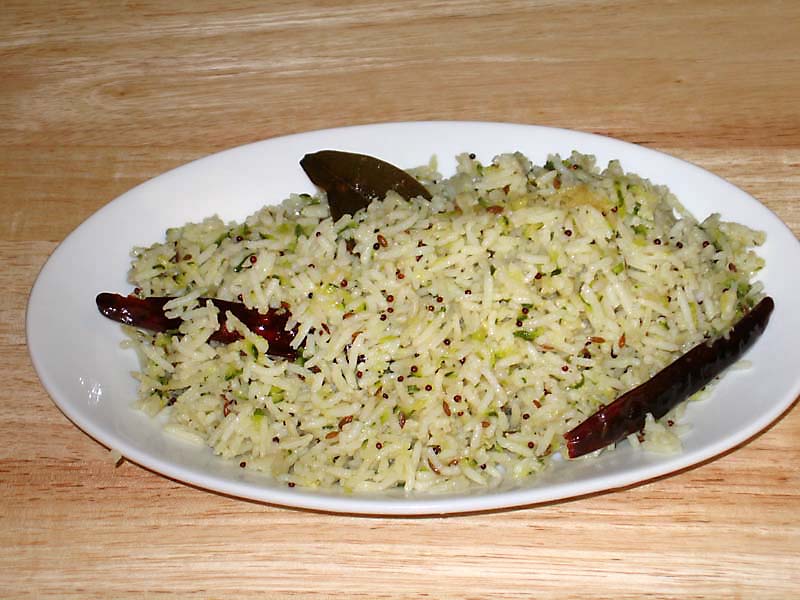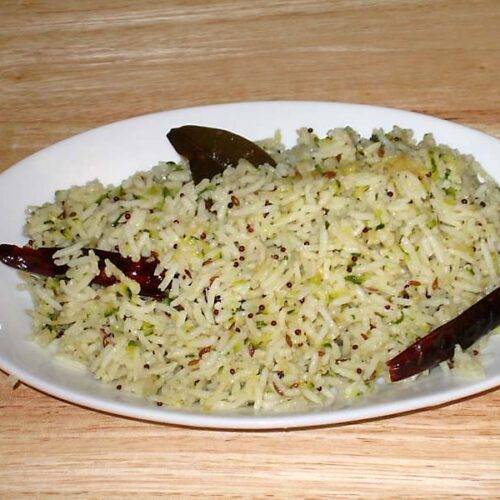Zucchini Rice
Ingredients
- 1 cup rice
- 2 cups water
- 1 cup shredded zucchini with skin
- 1 tbsp of oil
- 1 tsp of butter
- 1/2 tsp cumin seed jeera
- 1/2 tsp black mustard seed rai
- 4 red peppers whole
- 2 Bay Leaves tajpat
- 1/2 tsp salt
- 1/2 inch small piece of cinnamon stick dal chini
- 1 tsp lemon juice
Instructions
- Heat the oil and butter in a heavy saucepan over medium high heat.Test the heat by adding one cumin seed to oil; if the cumin cracks right away oil is ready.
- Add cumin seeds and mustard seeds to the oil. After seeds crack add red pepper and bay leaves. Add rice and stir-fry for about 2 minutes.
- Add water, zucchini, salt and lemon juice. Stir and bring to boil.
- After rice comes to a boil turn the heat down to low and cover the pan. Cook rice for about fifteen minutes or until the rice is tender and the water has evaporated.
- Serve as is, with soup, yogurt, and pickle.
Suggestions
- Melt some cheddar cheese over rice.
Variations
- Replace zucchini with 1 1/2 cup finally chopped spinach.
Elevate Your Cooking with Zucchini Rice: A Flavorful and Nutritious Delight
Zucchini rice offers a delightful gluten-free option for those seeking quick and easy vegan meals. Made primarily with rice and zucchini, this dish is not only flavorful but also nutritious. Zucchini, rich in vitamins and minerals, adds a refreshing crunch and subtle sweetness to the rice. With minimal ingredients and simple cooking methods, zucchini rice is perfect for busy weeknights or as a side dish for larger gatherings.
1. Heating the Oil and Butter: Preparing for Flavorful Zucchini Rice
Begin crafting the delightful zucchini rice by heating a combination of oil and butter in a sturdy saucepan over medium-high heat. To ensure the oil reaches the optimal temperature for sautéing, conduct a quick test by introducing a single cumin seed into the oil. If the seed crackles upon contact, it signifies that the oil is primed and ready to infuse its essence into the dish.
2. Tempering the Spices: Enhancing Aromatics in Zucchini Rice Recipe
Elevate the flavor profile of the rice zucchini recipe by adding a medley of aromatic spices to the heated oil and butter. Sprinkle in cumin seeds and mustard seeds, allowing them to crackle and release their enticing aroma into the culinary canvas. Follow this with the addition of red pepper and bay leaves, infusing the dish with layers of complexity and depth.
3. Sautéing the Rice: Fostering Texture and Flavor in Zucchini Rice Recipes
Introduce the rice to the fragrant spice blend, stirring vigorously to coat each grain with the aromatic oils. Continue to stir-fry the rice for approximately 2 minutes, coaxing out its nutty flavors and enhancing its texture in preparation for the upcoming infusion of moisture and flavor.
4. Adding Water and Zucchini: Building Layers of Flavor in Rice Zucchini Recipe
Elevate the zucchini rice recipe to new heights by incorporating water, fresh zucchini, salt, and a splash of invigorating lemon juice into the saucepan. Stir the mixture well, allowing the flavors to meld harmoniously as it comes to a gentle boil, infusing the rice with the vibrant essence of the zucchini and citrus.
5. Simmering to Perfection: Achieving Tender Texture in Zucchini Rice
Once the rice mixture reaches a rolling boil, reduce the heat to low and cover the pan, initiating the gentle simmering process. Allow the rice to cook undisturbed for approximately fifteen minutes, or until the grains are tender and have absorbed the flavorful liquid, resulting in a tantalizing medley of textures and tastes in the completed zucchini rice recipes.
6. Serving Suggestions: Enhancing Enjoyment of Zucchini Rice
Indulge in the delightful simplicity of zucchini rice by serving it as is, alongside comforting accompaniments such as soup, yogurt, and pickle. For a decadent twist, consider melting a generous portion of cheddar cheese over the rice, imparting a luscious richness that elevates the dish to new heights of indulgence.
Suggestions for Variation: Experimenting with Flavors in Zucchini Rice
For a refreshing twist on the classic recipe, consider substituting zucchini with 1 1/2 cups of finely chopped spinach, infusing the dish with vibrant green hues and the earthy essence of leafy greens. This variation offers a delightful alternative for those seeking to explore new flavor profiles while retaining the comforting appeal of zucchini rice.
If you loved our zuchini rice recipe then you must also check out other variants of Rice: Vegetable Biryani, Masala Khichdi, Mango Rice, Quinoa Vegetable Pilaf and Lemon Rice.


